This August, to celebrate the upcoming release of Star Trek: Into Darkness on DVD and blu ray, we’re taking a look at the Star Trek movies featuring the original cast. Movie reviews are every Tuesday and Thursday.
Star Trek: The Motion Picture has a lot to recommend it. It’s big, thoughtful science-fiction, ripe with ideas and high-concepts tying directly into the root of the franchise. It gives both Kirk and Spock clear character arcs. It looks and sounds amazing, demonstrating just how far special effects had evolved in the decade since the show went off the air. However, it suffers from a pace that might best be described as “glacial”, and a sense that – for all the grand ideas – we aren’t really boldly going anywhere that new. Elements of the film can’t help but recall both the 1968 science-fiction classic 2001: A Space Odyssey and even the show’s own episode The Changeling.
While it’s easy to admire The Motion Picture, it’s a lot harder to enjoy it.
The Motion Picture takes its own time, something I quite appreciate. It even opens with an overture before the now-familiar Paramount logo, inviting the audience to take a trip into space before they worry about the opening credits or the story itself. There’s a remarkable sense of comfort and ease with this, and it’s very hard to believe any major blockbuster produced within the past couple of decades could be so comfortable setting so casual a pace.
Indeed, even the films directly following The Motion Picture – Star Trek II: The Wrath of the Khan or Star Trek III: The Search for Spock – moved at a much brisker pace. While Robert Wise is able to establish a sense of mood and place effectively, The Motion Picture suffers quite a bit because there simply isn’t enough here to sustain a movie running over two hours. An alien probe is slowly making its way towards Earth for some unknown purpose, with the capacity to wipe out everything living on the planet. That was the basis of the first fifteen minutes of Star Trek IV: The Voyage Home. Here, it is the entire film.
That’s not to suggest that there isn’t room for exploration or development, but The Motion Picture often feels far too relaxed and too complacent. For better or worse, The Motion Picture was the first live action Star Trek plot to feature a direct alien menace to Earth. Since then, threats to the planet have become the franchise norm, especially on the big screen. Even the latest installment, Star Trek: Into Darkness, gets in on the act. However, despite the fact that The Motion Picture introduces what would soon become a staple of these big-screen adventures, things never seem tense or potentially precarious.
“Mister Scott, there’s an alien object with unbelievable destructive power less than three days away from this planet,” Kirk explains. “The only starship in interception range is the Enterprise.” That seems a little strange and surreal by itself. Given the Federation has been on the brink of war with the Klingons since Errand of Mercy and Earth has been involved in an interstellar war with the Romulans, you’d imagine the planet would have a last a first any line of defense against potentially hostile invaders, particularly given the fact that they spotted this thing near Klingon space.
However, despite the fact that the fate of the planet is resting on the Enterprise, everything seems remarkably casual and relaxed. It just sort of is, in a broad zen sense. There’s no real suspense or urgency. To be fair, this fits with the broadly optimistic philosophy of the franchise, and Kirk makes a point not to provoke “the intruder”, which is a nice touch. That said, wonder and suspense are not mutually exclusive. And – if you are going to threaten to destroy the world in your movie – you should probably acknowledge that the stakes have been raised a bit.
That’s the biggest problem with the pacing of The Motion Picture. A two-hour movie can fly by, if paced properly. All is forgiven if the narrative moves fast enough to create the impression that this considerable length is the most you could pare the story down to without losing anything. It’s harder to forgive when a movie with a long runtime wanders rather than charges, and particularly is a lot of it feels very familiar. There are a lot of episodes of Star Trek that might clamour for a big-screen adaptation. The Changeling is not one of them.
Still, despite that, there’s a lot of interest here. Most notably, there’s the fact that it got made. Greenlighted following the success of Star Wars, I respect the studio for daring to do something relatively different rather than attempting to emulate the competition. Produced in 1979, a decade after the last show aired, it’s also nice to see Star Trek given the production budget and design it deserves. While the classic television show had a charming aesthetic, The Motion Picture really codified how Star Trek would look from that point forward.
Indeed, The Motion Picture demonstrated that the franchise could look convincing and pseudo-realistic. While Star Trek: Enterprise was never entirely convincing as a prequel to the classic television show, The Motion Picture looks a lot more viable as a future evolution of the technology on display there. Visually, The Motion Picture is quite impressive. Incorrectly identified by The Guinness Book of World Records as the most expensive movie made at the time (Superman was more expensive), The Motion Picture still looks quite stunning.
Some of the external special effects haven’t aged perfectly, but the sets and the set pieces all seem like they were crafted for a classic Hollywood epic, a large-scale studio production. For all its pacing and plot problems, The Motion Picture has a certain poise and dignity that is hard to deny. It just feels classy. As indulgent as it might be, that extended shuttle pass of the new Enterprise refit is an iconic sequence for a reason, one homaged throughout the franchise – whether in Abrams’ Star Trek or in All Good Things…
There is an interesting conflict at the heart of The Motion Picture, the last Star Trek production of the seventies. Aesthetically, the production is very clearly rooted in the seventies or eighties. The uniforms are more muted tones, looking more like space-age jumpsuits than brightly-coloured sweaters and sharp sideburns. Uhura and Chapel even get to wear pants, which is much better than Roddenberry’s idea in Encounter at Farpoint of forcing men to wear skirts.
When McCoy himself come on board, he’s presented as a relic of the sixties. He looks like he has been living in a hippy commune. He’s grown a great big bushy beard and is even wearing a medallion under his open shirt. McCoy, it seems, has fully embraced counter-culture in his time away from the ship, becoming a left-over piece of the sixties Star Trek in need of an update. When Jim explains the situation to Bones, McCoy gets all existential on him, “Why is any object we don’t understand always called a ‘thing’?”
He’s less than happy to be working for Starfleet, the establishment, again. “They drafted me,” he tells Jim, calling to mind the infamous Vietnam draft, which had ended four years after the show, but six years before the film. McCoy is introduced as outdated, and out-of-touch – perhaps reflecting the franchise itself. However, we’re assured that this retro vibe is purely cosmetic. Soon enough he’s in uniform, his beard is shaved and his medallion is gone. Like the franchise itself, he only needed to clean up a little bit.
And yet, despite that obvious acknowledgement that time is marching onwards, there are still some suggestions that Star Trek is still stuck in the sixties. Consider the character of Ilia, a character so sensuous she had to take an “oath of celibacy” to work in Starfleet. It turns out that – in perfect Roddenberry style – she’s a beautiful alien who has a culture based entirely around sex according to the Phase II Writers’ Guide:
Just as Vulcans have a problem with emotions, Ilia has a problem which accompanies her aboard the starship. On 114-Delta V, almost everything in life is sex-oriented — it is a part of every friendship, every social engagement, every profession. It is simply the normal way to relate with others there. Since constant sex is not the pattern of humans and others aboard this starship, Ilia has totally repressed this emotion drive and social pattern.
How very sixties. And, in a way, it very clearly foreshadows some of the difficulties that Gene Roddenberry would have writing Star Trek: The Next Generation in the eighties and nineties. While references to sixties sexual subculture were embarrassing in the late seventies, they were unforgivable during the AIDS scare of the late eighties. The root of the problem with first-season Next Generation episodes like Justice or The Naked Now can be traced back to this.
Which brings us to an interesting aspect of The Motion Picture. It serves as something of a nexus between Star Trek and the spin-offs and sequels. Obviously, the look and feel of The Motion Picture informed the spin-offs to a large degree. The bulkheads and panels on show here will seem quite familiar to anybody with even a passing awareness of The Next Generation. Oh, and Klingons have ridges. However, that’s only the tip of the proverbial iceberg.
The Motion Picture was essentially a big-screen adaptation of an aborted pilot for a Star Trek show that almost came to pass. In Thy Image, the script which informed The Motion Picture, was written to launch Phase II. A lot of Phase II would seep through into the later Star Trek shows. For example, the character of Data in The Next Generation seems quite strongly modelled on the character of Xon. Scripts for Phase II stories like The Child and Devil’s Due would be recycled for The Next Generation.
Particularly obvious when watching The Motion Picture is the fact that the two new cast members – Decker and Ilia – would both appear in The Next Generation. The younger upstart first officer would become William T. Riker, and he would share a romantic history with the ambiguously foreign sensuous alien Deanna Troi. Like Ilia, Troi would be defined by her relationship to “feelings”, in contrast to Spock’s relationship with his own emotions.
There’s also the fact that “the intruder” seems to foreshadow one of the most iconic additions made to the mythos following the original Star Trek. With all the talk about the “machine planet” and “living machines”, V’Ger feels like a fore-runner to the Borg. Indeed, several lines of dialogue seem oddly prophetic. “Any show of resistance would be futile, Captain,” Spock muses. The machine’s central objectives – “collect all data possible” and “learn all that is learnable” – seem quite familiar, even if V’Ger’s methodology is quite distinct from that of the Borg.
The connection has become a popular part of fan lore. According to the Star Trek Chronology, even Roddenberry himself acknowledged the possible link:
Following production of Q Who? (TNG), Gene Roddenberry half jokingly speculated that the planet encountered by Voyager might have been the Borg homeworld.
William Shatner’s Star Trek novels would turn this into a key plot point. It’s a nice intangible link, one which suggests some grand and unknowable alienness beyond our comprehension. Life so strange it does not recognise us as life.
The Motion Picture also contains a few interesting character beats for both Kirk and Spock. In particular, the script acknowledges that Kirk is something of a flawed leader, and a bit of a jerk. He arrives on the Enterprise to relieve Decker of command, but doesn’t notify him beforehand. Decker is understandably upset, and even McCoy is sharp enough to see that Kirk is taking advantage of the situation. “You rammed getting this command down Starfleet’s throat. You’ve used this emergency to get Enterprise back.”
Several times over the course of The Motion Picture, Kirk is proven to be incorrect. Explaining why he has been chosen to relieve Decker of command, Kirk points out, “My experience, five years out there dealing with unknowns like this, my familiarity with the Enterprise, this crew.” Decker rather astutely counters, “Admiral, this is an almost totally new Enterprise. You don’t know her a tenth as well as I do.” His criticisms are borne out when Kirk can’t even find the appropriate turboshaft, or when Decker prevents Kirk from making a mistake in the wormhole leaving the system.
Kirk is allowed to be flawed as a character, in a way that Roddenberry never allowed with the cast of The Next Generation, and I’d argue that Kirk comes across much better for it. This characterisation would really pay off until The Wrath of Khan, but it does make it clear that Kirk is more than just a charming rogue. He’s also arrogant and self-interested, characteristics hinted at on the show but never fully developed.
The Motion Picture also provides a nice character arc for Spock, as the Vulcan finally attempts to purge himself completely of all his emotion. It feels like a logical place to join Spock, and sets up his character conflict quite nicely. As an aside, I also love how The Motion Picture acknowledges Spock’s dual nature by pointing out that “first officer” and “science officer” would normally be two separate positions. Reflecting the split between Spock’s human and Vulcan halves, the positions are originally filled by a human (Decker) and a Vulcan (Xon).
However, despite this interesting hook, The Motion Picture never quite develops the Spock plot line as a much as it should. It feels – given the ultimate pay-off – that this should be Spock’s story. Spock was on the cusp of eliminating all feeling, becoming completely machines, only to discover a machine that needed to embrace humanity. It feels like the two arcs should be more clearly paralleled. When Spock has his breakthrough about V’Ger (“this simple feeling… is beyond V’Ger’s comprehension; no meaning… no hope… and, Jim, no answers…”) he’s really having a breakthrough about himself. It’s a big moment for Spock, but it sort of gets brushed aside.
Still, there is a lot to recommend The Motion Picture. It’s just frustrating that… well, there’s not more motion.
Check out our reviews of the Star Trek movies featuring the original cast:
- Star Trek: The Motion Picture
- Supplemental: Leonard McCoy, Frontier Doctor by John Byrne
- Supplemental: Ex Machina by Christopher L. Bennett
- Supplemental: Crucible – Spock: The Fire and the Rose by David R. George III
- Star Trek II: The Wrath of Khan
- Supplemental: Space Seed
- Supplemental: Reign in Hell: The Exile of Khan Noonien Singh by Greg Cox
- Supplemental: Star Trek (DC Comics, 1984) #7-8 – Saavik’s Story
- Supplemental: The Pandora Principle by Carolyn Clowes
- Supplemental: Myriad Universes – Echoes and Refractions: The Chimes at Midnight by Geoff Trowbridge
- Star Trek III: The Search for Spock
- Supplemental: The Klingons: Starfleet Intelligence Manual (FASA)
- Supplemental: Star Trek (DC Comics, 1984) #28 – The Last Word
- Star Trek IV: The Voyage Home
- Supplemental: Star Trek Special #1 (DC Comics, 1994) – The Needs of the One
- Supplemental: Unspoken Truth by Margaret Wander Bonanno
- Supplemental: Music of the Spheres by Margaret Wander Bonanno
- Star Trek V: The Final Frontier
- Supplemental: The Ashes of Eden by William Shatner et al (DC Comics)
- Supplemental: Dwellers in the Crucible by Margaret Wander Bonanno
- Star Trek VI: The Undiscovered Country
- Supplemental: In the Name of Honour by Dayton Ward
- Supplemental: Star Trek Special #2 (DC Comics, 1994) – A Question of Loyalty
- Supplemental: Excelsior – Forged in Fire by Michael A. Martin and Andy Mangels
- Supplemental: Shadows on the Sun by Michael Jan Friedman
- Supplemental: Cast no Shadow by James Swallow
- Epilogue: Star Trek: Generations
Filed under: Non-Review Reviews | Tagged: Admiral, borg, gene roddenberry, james t. kirk, kirk, Klingon, Leonard McCoy, List of Star Trek characters (T–Z), Motion Picture, Motion Picture - Star Trek, spock, Star Trek II: The Wrath of Khan, Star Trek III: The Search For Spock, Star Trek Into Darkness, star trek iv the voyage home, Star Trek Next Generation, Star Trek: The Motion Picture, star trek: the original series, StarTrek |


















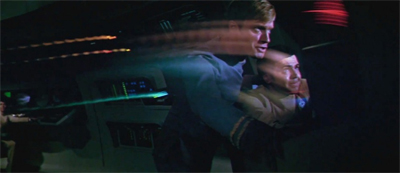
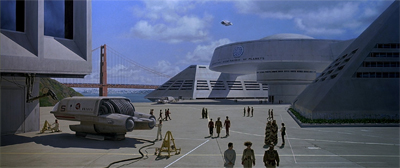
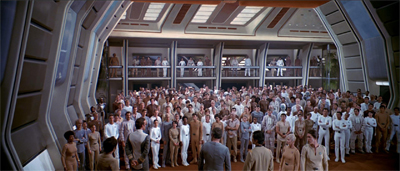

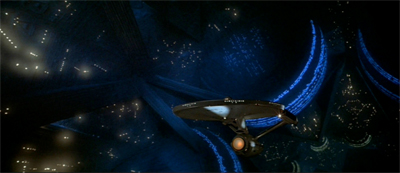
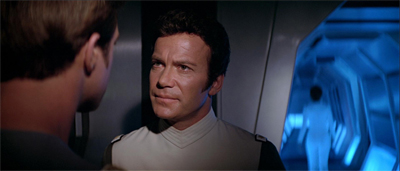
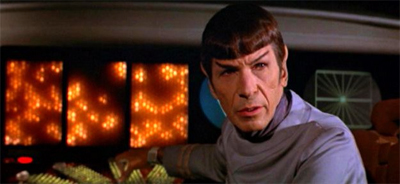

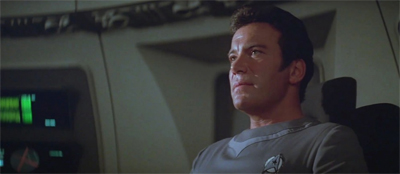






I’ve always felt that The Motion Picture has a lot to offer and I’ve never once not enjoyed watching it (and I’ve probably seen it about a hundred times along with all the other Trek films).
It’s the original crew getting back together to face seemingly insurmountable odds, set against a hard-sf backdrop with some luscious visuals (I love the cloud sequence) and Jerry Goldsmith’s beautiful and haunting score.
Sure it’s ponderous and there is the pacing issue but one of my favourite films is 2001. Robert Wise’s Director’s Edition which came out on DVD some years ago tightened the pace a little and restored some of the missing character moments and also incorporated some new effects (a la the remastered original series) – it’s a shame the blu-ray release is only the inferior theatrical version of the film.
I actually like the Director’s Cut a lot more than the Theatrical one. It’s a shame that it’s never been released on blu ray. Indeed, the whole box set could use some fancy-schmancy remastering, like TOS or TNG have received. Then again, I think the rights issues with the film might be more precarious, so I don’t know if we’ll see anything soon.
Apparently the reason why the TMP Director’s Cut never got a blu ray release is a depressingly common one for stuff being done in the early 2000s… All the tweaks and new CGI were only done at Standard Definition so a HD version doesn’t actually exist, and the company that did the DC (Foundation Imaging) no longer exist.
Ah, that’s bleak and depressing.
Ah, The Motion Picture… proving that good ideas don’t equal a better movie.
Well, they did when they were used in 2001: A Space Odyssey!
That movie did those ideas well. The Motion Picture did not.
More to the point, though, there were points at which The Motion Picture felt like it was rather shamelessly ripping off a much better film. (Badly, to be fair.) I suspect people’d be a lot more forgiving of TMP if 2001 didn’t exist.
Yep, the Motionless Picture, a film I’ve only managed to finish from start to finish once in my entire life, and I’m someone who can sit through hours of C-SPAN. Not going to beat a dead horse by listing all the common complaints though, everyone knows its a bad film.
What I do gather from this film is Roddenberry honestly thought he was going to make an epic, Academy Award for Best Picture nominated classic that everyone would mention alongside the other Sci-Fi greats, and of course I guess he was really dumb enough to think blatantly ripping off 2001 was the way to do it (alongside an episode of TOS he didn’t even write). However, I don’t think critics would ever treat a Star Trek film in that way, even if it really were that great.
Also, actually not everyone dislikes this film, I’ve encountered and met people who consider it the only “true” Trek film. I believe the film critic Plinkett also considers it the greatest Trek film (while disliking fan favorites like Star Trek II and Star Trek First Contact). How anyone can sit down and be entertained by this bewilders me, it literally is like watching paint dry.
On a side note, how much of this was changed from its transition to film from TV pilot?
I just watched this for the first time, and I gotta say, i didn’t hate it. It’s smart, sweeping, beautifully shot and scored. Perhaps it’s biggest flaw is that it’s hemmed in by the barriers of Trek. A good visual communication of this is how pedestrian the blocking and framing is on the Enterprise compared to everything else. I wonder how kids today will feel being introduced to Shatner as a meme then finding out he’s far more subtle than they would have thought!
Darren, are you interested in fan edits at all?
If so, I HIGHLY recommend you check out this editing of the film: it tells the exact same story, but far better.
How is it better? Well for one, the pacing is tremendously improved – (“the same cerebral journey but at Warp-Speed instead of just Impulse-Power”). Two, the color of the film is phenomenal! The film feels very much alive.
https://ifdb.fanedit.org/star-trek-reunion/
As an aside, it always bothers me when critiques of the film are brushed aside by people who believe it’s poor reception was because it’s too cerebral for the general audience. Sure it’s less action-oriented – but that’s not the primary reason for it’s lukewarm reception.
Interesting. I don’t generally have time for fan edits, but I did make the time for the soundtrack-only version of The Last Jedi. This sounds interesting.
darren: I have a question about the movie: if in the crew remain scotty (second officer in TOS); sulu and uhura (both liutenants in TOS) why is decker the captain?? even scotty wich has commanded the ship in may episides (TOS and TAS) thinks that decker is too inexperienced for the task. sorry for my english im from argentina